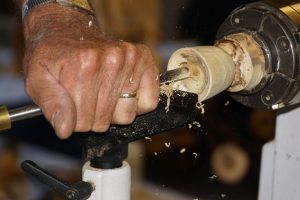
Lathes are one of the most versatile machining tools used in the manufacturing industry. While typically used for cutting and turning operations, they can also be used for sanding, drilling and facing. Not to be confused with milling machines, lathes are designed to rotate a workpiece against a stationary cutting tool. Below, you’ll find several common lathe lathes and their respective definition.
#1) Headstock
Found on either the left or right end of a lathe, the headstock is responsible for rotating the workpiece. It contains bearings that allow the workpiece to rotate against the stationary cutting tool.
#2) Spindle
In addition to a headstock, lathes also contain a spindle. Spindles are hollow and feature threading on the outside, allowing them to “spin” freely. Some spindles are driven manually via a foot pedal, whereas others are driven automatically via a motor.
#3) Faceplate
While not used in all lathes, many lathes feature a faceplate. The purpose of the faceplate is to hold the workpiece in place. Prior to using a lathe, manufacturing companies will secure the workpiece to the faceplate. This is typically done by running a screw or bolt through both the workpiece as well as the faceplate. Once secured, the lathe is engaged, thereby rotating the workpiece against a stationary cutting tool.
#4) Jeweler’s Lathe
A jeweler’s lathe is a special type of lathe that’s designed specifically for small objects and workpieces. Based on their name alone, you may assume that jeweler’s lathes are only used for jewelry, such as watches, but this isn’t necessarily true. They can be used to machine most small objects and workpieces. Jeweler’s lathes feature many of the same components as conventional lathes, but they are scaled down to offer a convenient and effective machining tool for small objects and workpieces.
#5) Bed
The bed of a lathe is the horizontal beam on which the workpiece, as well as most of the lathe’s components, are placed. The only exception is CNC lathes, which typically have a vertical beam to minimize the accumulation of swarf (see below). With a vertical bed, swarf falls freely to the floor rather than accumulating in and around the workpiece.
#6) Swarf
Regardless of the operation for which it’s used — cutting, sanding, turning, etc. — lathes will almost always product swarf. Also known simply as chips, swarf consists of material that’s removed from a workpiece. Whether a workpiece is made of wood or metal, a lathe will remove some of its material. The term used to describe this material is “swarf.”
No tags for this post.